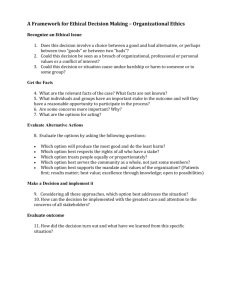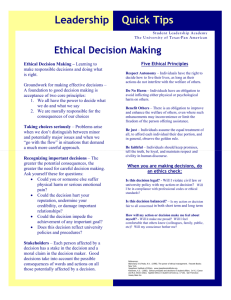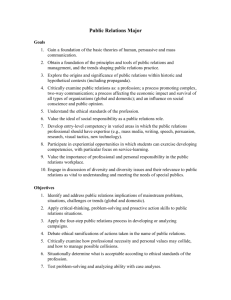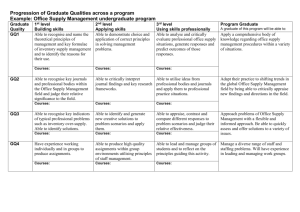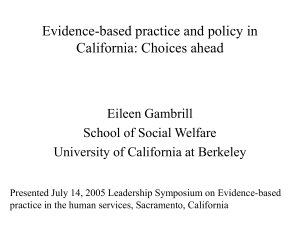Our Code of ethics as a guide for negotiating the realities of
advertisement
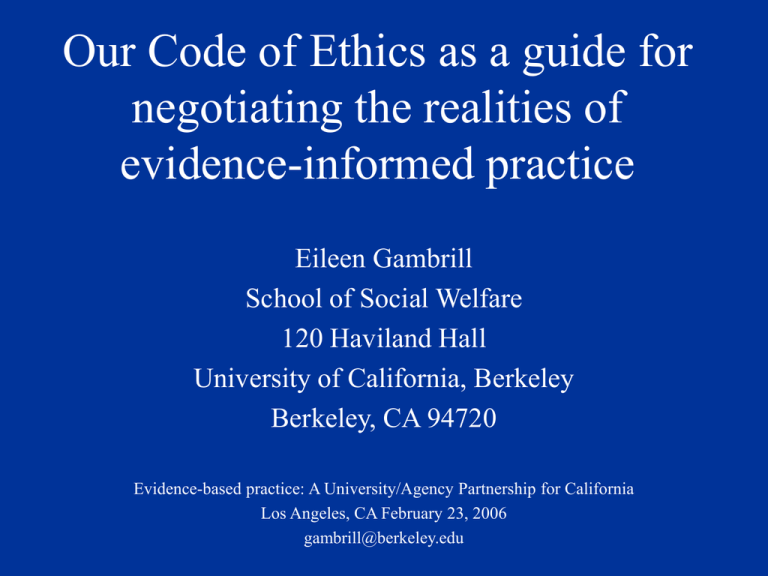
Our Code of Ethics as a guide for negotiating the realities of evidence-informed practice Eileen Gambrill School of Social Welfare 120 Haviland Hall University of California, Berkeley Berkeley, CA 94720 Evidence-based practice: A University/Agency Partnership for California Los Angeles, CA February 23, 2006 gambrill@berkeley.edu Ethical Obligations • • • • Beneficence Nonmalfeasance Self-determination (informed consent) Justice (equitable distribution of scarce resources) Questions • Are we helping? Who are we helping in what ways? How can we find out? • Are we harming? Who and in what ways? How can we find out? • Are decisions well reasoned and informed? Are decisions based on practice related research? • Are clients fully informed? • Have we identified content and procedural knowledge that contributes to success/harm avoidance? Evidence-informed practice • A way to handle the uncertainty associated with making decisions in an ethical manner (Chalmers, 2003). • Involved consumers – Those who make clinical decisions (clients, families, and clinicians) – Purchasers and providers making managerial decisions – Those making policy decisions at all levels of government Ethical obligations of researchers • To use research methods that critically test questions addressed • To accurately and clearly describe what was done and to what effect • To accurately describe well-argued alternative views and related evidence • To avoid inflated claims Ethical obligations of administrators • To use resources wisely; equitable distribution • To confront clashes between individual preferences and population needs and make just decisions • To create an organizational culture that encourages ethical decisions Ethical obligations of administrators, cont. • Each agency should accurately describe each service provided, including those purchased, using the following (Gray, 2001): – Services critically tested and found to do more good than harm – Services of unknown effects – Services critically tested and found to do more harm than good – Services of unknown effect but in high quality research program Some key decisions 1. Whether and how to involve clients or consumer group representatives: – In conducting and reviewing research (Consumer participation may enhance the quality, relevance and influence of reviews) – In deciding what services to provide – In planning how to overcome application barriers Some key decisions, cont. 2. Whether to attend to the ethics of excuses – – – We were too busy They told us to do it Other people do it 3. Whether to address application barriers • These include organizational barriers, common cognitive biases (Gambrill, 2005), and the burden of knowledge. Some key decisions, cont. 4. Whether to arrange open communities of inquiry including: – There is a focus on critically testing claims; for example critical appraisal of agency services is encouraged – Errors and mistakes are identified (as well as related causes) and are viewed as learning opportunities to improve services – Propaganda strategies as minimized – Knowledge is viewed as hypothetical/tentative – There is an awareness that we are all equal in out vast ignorance (Popper)
